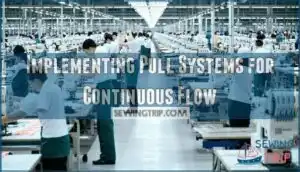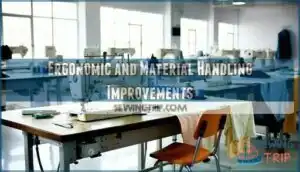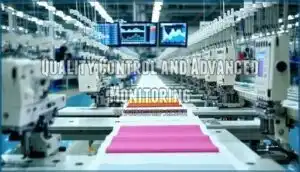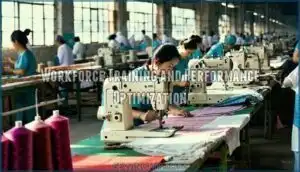This site is supported by our readers. We may earn a commission, at no cost to you, if you purchase through links.

Walk any production line and you’ll spot the same pattern: the difference between shops hitting 80 pieces per hour and those consistently pushing 120 isn’t newer equipment or cheaper labor, it’s ruthless attention to the mechanics of how work actually flows through your machines and stations.
When you master sewing machine optimization techniques—from needle selection and tension calibration to line balancing and real-time monitoring—you don’t just trim waste, you fundamentally rewire your operation’s DNA for speed, quality, and profit.
Table Of Contents
Key Takeaways
- Your sewing floor’s efficiency gap between 80 and 120 pieces per hour comes down to mastering machine optimization techniques—precise needle selection, tension calibration, line balancing, and real-time monitoring—not newer equipment or cheaper labor.
- Strategic layout redesign that minimizes material movement by 30-50%, removes bottlenecks through time studies, and implements pull systems can push line efficiency from 63% to 94% while cutting defects nearly in half.
- AI-powered quality control systems now achieve 99.99% defect detection accuracy compared to manual inspection’s 84.51%, slashing inspection time by 60-80% and reducing product returns by 40% while cutting material waste by 25%.
- Operator multiskilling paired with standardized training modules compresses ramp-up time from 21 days to 14 days, achieves 80% efficiency by day 12, and reduces idle time by 20-35% across production lines.
Optimizing Sewing Line Layout for Efficiency
Your sewing line’s layout controls how fast work moves and where bottlenecks form. A smart arrangement reduces wasted steps, keeps operators productive, and prevents materials from sitting idle.
Let’s look at how to set up your line for maximum throughput with minimal friction.
Minimizing Material Movement
Every inch of wasted movement in your sewing line is bleeding time and money. Cut distances by 30-50% through smart layout planning, and you’ll watch productivity climb while operator fatigue drops.
Start with mapping your material flow from warehouse layout through each workstation—identify where bundles travel farthest and reconfigure stations accordingly.
When you combine smart line layout with solid inventory management, you’re setting up a supply chain that works smoothly from the start.
This logistics foundation boosts your sewing efficiency naturally—before you even get into the details of balancing workloads or cross-training operators.
Removing Bottlenecks From Operations
Bottleneck identification starts with process mapping—track each operation’s cycle time and spot where work piles up. Time studies reveal that removing just one bottleneck can push line efficiency from 63% to 94%, while cutting defects nearly in half.
Apply line balancing techniques and watch your output jump from 80 to 120 pieces per hour without adding headcount.
Workflow optimization through efficiency metrics and production planning eliminates non-value activities, transforming sewing line optimization into measurable efficiency improvement and production optimization gains. By utilizing smart automation technologies, manufacturers can further improve their production processes.
Balancing Workloads and Operator Multiskilling
Once you’ve cleared the line blockages, the next step is training your operators to flex across multiple workstations—multiskilling turns static bottlenecks into fluid solutions and keeps every station humming.
Workload analysis paired with operator training reveals where skills overlap and where gaps slow you down:
- Multiskill development programs cross-train operators on 3–5 adjacent tasks for smooth coverage
- Efficiency metrics track real-time cycle time and identify underutilized talent
- Productivity tracking dashboards show which operators manage multiple operations best
- Line balancing redistributes tasks based on operator strengths and workload peaks
- Operator multiskilling reduces idle time by 20–35%, driving sewing efficiency and efficiency improvement across the entire sewing line optimization chain
Implementing Pull Systems for Continuous Flow
Once your operators can shift between stations, pull systems keep that flexibility productive by releasing work only when downstream stations are ready—no backups, no gaps, just consistent flow from cutting through final assembly.
Just-in-time principles optimize flow by activating upstream operations on demand, which cuts excess inventory and sustains continuous production.
Supply chain management grows stronger when continuous work supply pairs with line balancing—operators pull precisely what they need, streamlining production while exposing bottlenecks immediately.
| Pull System Design Element | Impact on Sewing Efficiency | Implementation Tool |
|---|---|---|
| Visual Kanban signals | Reduces WIP by 30–40% | Color-coded cards or lights |
| Demand-triggered replenishment | Cuts lead time 15–25% | Electronic pull alerts |
| Station-to-station handoff rules | Balances cycle time variance | Standardized work protocols |
Enhancing Sewing Machine Performance
Your sewing machine’s performance depends on a few critical variables that directly affect stitch quality and production speed. Thread tension, needle selection, speed settings, and automation features can make or break your workflow—get them right, and you’ll avoid constant troubleshooting.
Here’s what you need to know to fine-tune your machines for consistent, high-quality output.
Factors Affecting Thread Tension
Thread tension isn’t something you set once and forget—it’s a living adjustment that reacts to everything from thread quality to humidity in your shop. Low-quality threads can wear your components 30% faster, while cotton versus polyester demands completely different tension approaches. Your machine calibration matters, but so does the environment around it.
Key factors you need to monitor:
- Thread Quality affects drag through tension discs—premium threads reduce wear and maintain consistent flow
- Fabric Interactions require adjustments: denim needs higher tension settings while silk demands lighter touch to prevent puckering
- Environmental Factors like humidity alter thread flexibility, forcing you to recalibrate for ideal stitch quality
- Threading Accuracy accounts for most tension problems—one missed guide disrupts the entire pathway and creates visible flaws
Understanding ideal thread tension settings is vital for achieving professional embroidery results.
Needle Selection for Optimal Results
Your needle choice directly impacts sewing machine optimization techniques and overall sewing efficiency. Universal needles dominate roughly 28% of global revenue, but fabric compatibility demands precision—use NM 60/8 for silk, NM 100/16 for denim.
Needle geometry and materials like titanium coatings reduce friction, while proper selection prevents fiber damage and maintains thread tension. Match needle size to fabric weight and sewing speed for best results in sewing technology applications.
Speed Adjustment for Different Fabrics
Adjusting your machine’s speed to match fabric characteristics can slash defects by up to 40% while protecting both material and equipment from unnecessary stress. Speed calibration transforms sewing efficiency—here’s your control panel:
- Delicate fabrics (silk, chiffon): Run at 1,500-2,500 SPM to prevent thread breakage and maintain fabric tension
- Medium-weight materials (cotton, linen): Fine-tune stitch quality at 3,000-4,000 SPM with balanced material feed
- Heavy textiles (denim, canvas): Push to 4,500+ SPM using stitch regulation for consistent penetration
- Stretch fabrics: Reduce speed 20-30% to control material feed distortion
Modern sewing machine technology with digital interfaces lets you dial in precise machine speed for each fabric type, eliminating guesswork from your thread and fabric selection process.
Programmable Stitch Patterns and Automation
Programmable stitch patterns eliminate the repetitive manual setup that’s been draining your production hours—imagine storing hundreds of complex designs and executing them with a single button press.
Today’s automated sewing systems combine digital pattern storage with machine learning, letting the equipment adjust its own tension and speed as it works.
Modern factories are putting automated sewing machines with built-in robotics on their production lines, where stitch optimization adjusts itself on the fly using technology that gets smarter with each pass.
Ergonomic and Material Handling Improvements
Your sewing floor’s physical setup directly impacts how fast work flows and how comfortable your operators feel during long shifts. Smart ergonomic design paired with efficient material management cuts wasted motion and keeps production moving without bottlenecks.
Let’s walk through practical ways to redesign your workspace so it boosts both efficiency and operator wellbeing.
Ergonomic Workstation Design
Your sewing floor setup can make or break productivity—and your operators’ health. Ergonomic Workstation Design tackles both through strategic furniture choices and layout planning.
Start with Ergonomic Chairs featuring adjustable height and backrest support; studies show they reduce musculoskeletal complaints by up to 80%. Pair these with Adjustable Workstations that allow sit-stand flexibility, cutting static posture stress while boosting Sewing Efficiency.
Workspace Lighting should reach 1,000 lux at task level to prevent eye strain. Position work surfaces 10 cm above elbow height for natural Posture Correction, supporting Operator Comfort and Industrial Efficiency Optimization.
When you invest in better workspace design, you’ll see the payoff in both product quality and your team’s ability to take on new skills.
Reducing Unnecessary Motions
Every wasted motion on your production floor is money walking out the door—and operators repeat these inefficiencies thousands of times per shift. Motion Analysis identifies these productivity killers through time studies and video observation, driving Workflow Streamlining that bolsters Manufacturing Efficiency.
Target these high-impact areas:
- Position tools within 18-inch reach zones for prime Ergonomic Design
- Eliminate hand-to-hand fabric transfers between stations
- Use gravity-fed supply chutes to reduce bending
- Apply Line Balancing principles to minimize walking distances
- Track Efficiency Metrics like movements-per-garment to measure Sewing Efficiency gains
Combining Ergonomic Workstation Design with Operator Multiskilling creates fluid operations while protecting Operator Safety.
Efficient Material Handling Systems
Moving fabric efficiently between workstations cuts your cycle time just as dramatically as eliminating those wasted hand motions—but most factories still rely on outdated conveyor systems that create more problems than they solve. Modern Material Flow solutions integrate Logistics Optimization with Line Balancing to create smooth Supply Chain Efficiency.
| System Type | Impact on Manufacturing Efficiency | Implementation Priority |
|---|---|---|
| Overhead rail transport | Eliminates floor congestion, boosts Sewing Efficiency 30% | High |
| RFID bundle tracking | Real-time Inventory Management visibility | Medium |
| Gravity conveyors | Reduces operator manipulation, improves Continuous Work Supply | High |
| Automated guided vehicles | Optimizes Warehouse Systems routing | Low |
| Smart bin systems | Prevents Supply Chain bottlenecks | Medium |
When your Material Flow matches production demand, you’ll notice immediate improvements.
Continuous Work Supply Strategies
Your operators can’t stitch air—keeping bundles queued at every workstation without flooding the floor requires a pull-based replenishment system that corresponds to actual consumption, not guesswork. Here’s how Continuous Work Supply drives Manufacturing Productivity:
- Signal cards trigger Material Flow when inventory drops below threshold
- Production Scheduling software syncs Supply Chain replenishment with line consumption
- Visual boards display real-time Inventory Management status
- Cross-trained runners streamline Logistics Optimization routes between prep and assembly
That approach keeps your sewing operation running smoothly while avoiding supply chain slowdowns.
Quality Control and Advanced Monitoring
Quality control isn’t just about catching mistakes—it’s about preventing them before they happen. Modern monitoring systems give you the visibility and precision needed to stay ahead of defects, refine production flow, and maintain consistent output.
Today’s sewing operations are being reshaped by cutting-edge technologies that bring new levels of accuracy to quality assurance.
Integrating AI and Digital Quality Control
Harnessing AI Inspection and Digital QC transforms your Quality Control and Assurance into a precision tool for Smart Manufacturing. By 2025, 45% of textile manufacturers have integrated AI-powered systems, achieving over 99.99% accuracy in real-time defect detection—far surpassing manual inspection’s 84.51%.
This shift to Smart Factories with Industrial Automation cuts material waste by 25%, slashes inspection time by 60-80%, and boosts Sewing Efficiency through Predictive Maintenance. AI and Machine Learning enable Automated Defects identification before they cascade through production, delivering 30% throughput gains while reducing returns by 40%.
| AI/Digital QC Benefit | Measured Impact |
|---|---|
| Defect Detection Accuracy | 99.99% vs. 84.51% manual |
| Material Waste Reduction | Up to 25% decrease |
| Inspection Time Savings | 60-80% faster |
| Throughput Improvement | 30% increase |
| Product Return Reduction | 40% fewer returns |
Automated Defect Detection Technologies
Building on AI’s accuracy, Automated Defect Detection Technologies deploy Machine Vision and Deep Learning to catch flaws mid-production. Computer Vision systems now achieve 96.44% detection rates, replacing 8–10 inspectors and boosting productivity by 300–400%. These Automated Systems reduce payback periods to 18–24 months, transforming Automated Quality into a competitive edge.
- 92.3% broken-stitch detection with pre-trained CNN architectures in controlled runs
- StitchingNet dataset with 14,565+ annotated images trains AI Inspection models for wide-spectrum defects
- YOLOv8 Computer Vision delivers real-time classification on compact edge devices like Raspberry Pi 4
- $4.8 billion AI fabric-inspection market projected by 2033, fueled by Deep Learning and Predictive Maintenance demand
Real-Time Monitoring With IoT-Enabled Machines
When seconds count on the factory floor, IoT-enabled machines turn raw sensor data into the split-second insights you need to prevent costly downtime before it starts. Internet of Things platforms combine IoT sensors with machine learning algorithms to deliver predictive maintenance alerts across smart factories, slashing unplanned stops by up to 40%.
| IoT Feature | Key Benefit | Impact on Production |
|---|---|---|
| Real-time Data Analytics | Instant visibility into machine health | Reduces downtime by 30–40% |
| Predictive Maintenance alerts | Early fault detection | Extends equipment lifespan 20–25% |
| Remote diagnostics | Faster troubleshooting | Cuts repair time in half |
| Performance dashboards | Tracks throughput and efficiency | Boosts output 15–20% |
| Integration with Smart Factory Solutions | Smooth Automation in Textiles workflow | Improves overall productivity 25% |
This industrial sewing technology gives you command over every stitch, turning sewing machine automation benefits into measurable profit.
Implementing Lean and Process Optimization
When you combine lean methodologies with industrial engineering, you’re cutting out the waste that’s been draining your production line and replacing messy workflows with streamlined operations that actually make money.
Here’s what drives real improvement:
- Process Mapping reveals hidden bottlenecks and redundant steps across your supply chain.
- Lean Tools like 5S and Kaizen enable continuous manufacturing process optimization.
- Efficiency Metrics track line balance improvements, proving your optimization strategies deliver measurable sewing efficiency gains.
When you apply lean manufacturing, you’re turning spreadsheets and production data into clear steps that actually speed up your line.
Workforce Training and Performance Optimization
Your workforce powers sewing efficiency, but only when operators have the skills and motivation to back it up.
Training programs, performance tracking, and smart incentive structures turn average teams into high-output units.
Let’s look at ways to build a workforce that delivers real productivity gains.
Comprehensive Operator Training Techniques
Standardized Training Modules dramatically compress your learning curve, cutting operator ramp-up from 21 days down to just 14. With 80% Efficiency Improvement Strategies achieved by day 12, these modules ensure rapid skill acquisition. Digital Coaching through real-time video feedback accelerates Skill Development by 35%, while computer vision systems enhance Sewing Efficiency and Quality Control by minimizing errors.
By tracking clear performance metrics and providing regular feedback, this training framework directly improves how operators work on the floor.
| Training Component | Measurable Impact |
|---|---|
| Standardized modules with digital resources | 80% efficiency by day 12; 14-day training cycle |
| Real-time video feedback systems | 35% faster training; 12% production rate increase |
| Ergonomic movement integration | Significant fatigue reduction; fewer musculoskeletal complaints |
Skill Assessments and Incentive Programs
Regular skill assessments transform raw capability into measurable competitive advantage—turning your operators into precision assets who consistently hit production targets.
You’ll want to track Performance Metrics like stitch quality and cycle time, then pair your Productivity Analysis with performance-based Incentive Models that reward documented Skill Development.
When you use this method, your operators get better at their jobs while your quality control gets stronger.
It helps your sewing operation run more smoothly by giving workers the right training and development opportunities—and backing it up with real incentives that make your training investment pay off.
Monitoring Individual Performance
You can’t fix what you don’t track—and in high-volume sewing operations, real-time performance data separates operators who consistently deliver from those who drain your line’s efficiency.
Monitor these critical metrics to sharpen Operator Performance and drive Sewing Efficiency:
- Stitch quality and defect rates for Quality Control
- Cycle time variations affecting Line Balance
- Productivity Tracking dashboards with Operator Feedback loops
- Incentive Systems tied to Performance Metrics that fuel Skill Development
When you turn this raw data into actionable insights through garment production management, you’re building a foundation for measurable improvement.
Encouraging Skill Development for Efficiency
Investing in your operators’ growth isn’t just good leadership—it’s the fastest way to slash defects, speed up production, and turn your sewing floor into a profit machine.
Roll out Operator Training programs with Skill Incentives tied to Performance Monitoring results, and pair them with hands-on Efficiency Coaching sessions.
When you invest in this talent development approach, you’re applying proven industrial engineering principles that boost sewing efficiency and raise quality control standards.
This strategy moves your operation closer to peak performance, especially as you upgrade equipment.
Frequently Asked Questions (FAQs)
How often should machines be professionally serviced?
Professional service scheduling for industrial machines should occur every six months to maintain long-term reliability.
Preventive care through scheduled equipment upkeep reduces operational disruptions and extends machine life, ensuring peak performance across your production floor.
What needle types suit stretch fabrics best?
Ball-point needles work best for stretch fabrics because their rounded tip slides between fibers instead of piercing them.
This needle selection prevents snags and skipped stitches on knits, improving stitch quality and fabric management while maintaining sewing efficiency across different fabric types.
Which lubrication products prevent machine corrosion effectively?
Protecting your investment starts with choosing the right barrier against wear. Synthetic oils with rust inhibitors offer excellent corrosion prevention compared to petroleum-based options, extending machine life.
Maintaining ideal machine speed and tension adjustments ensures consistent embroidery machine maintenance.
How do digital twins improve maintenance scheduling?
Digital Twins create Virtual Modeling of your Sewing Machines, enabling Predictive Maintenance through Real-Time Monitoring and data analysis.
Automated Scheduling uses Artificial Intelligence to predict failures before they occur, maximizing Sewing Efficiency while reducing Manufacturing Technology downtime.
Conclusion
The difference between surviving and thriving in this industry isn’t rocket science—it’s the cumulative power of dozens of small, disciplined choices executed daily.
When you commit to sewing machine optimization techniques with the precision of a watchmaker and the vision of an engineer, every operator becomes faster, every machine runs smoother, and your margins stop evaporating into thin air.
The shops that dominate 2025 won’t be the ones with bigger budgets; they’ll be the ones that refused to tolerate another wasted motion.
- https://www.marketreportanalytics.com/reports/automation-in-textile-industry-market-9473
- https://textilefocus.com/the-role-of-ai-and-automation-in-textile-manufacturing/
- https://sewersclub.com/blogs/sewing-and-instructional/sewing-machine-maintenance-101-keeping-your-machine-in-top-shape
- https://scissortailquilting.com/tutorials-instruction/clean-maintain-sewing-machine-maintenance/
- https://www.sciencedirect.com/science/article/pii/S2213846324002827














